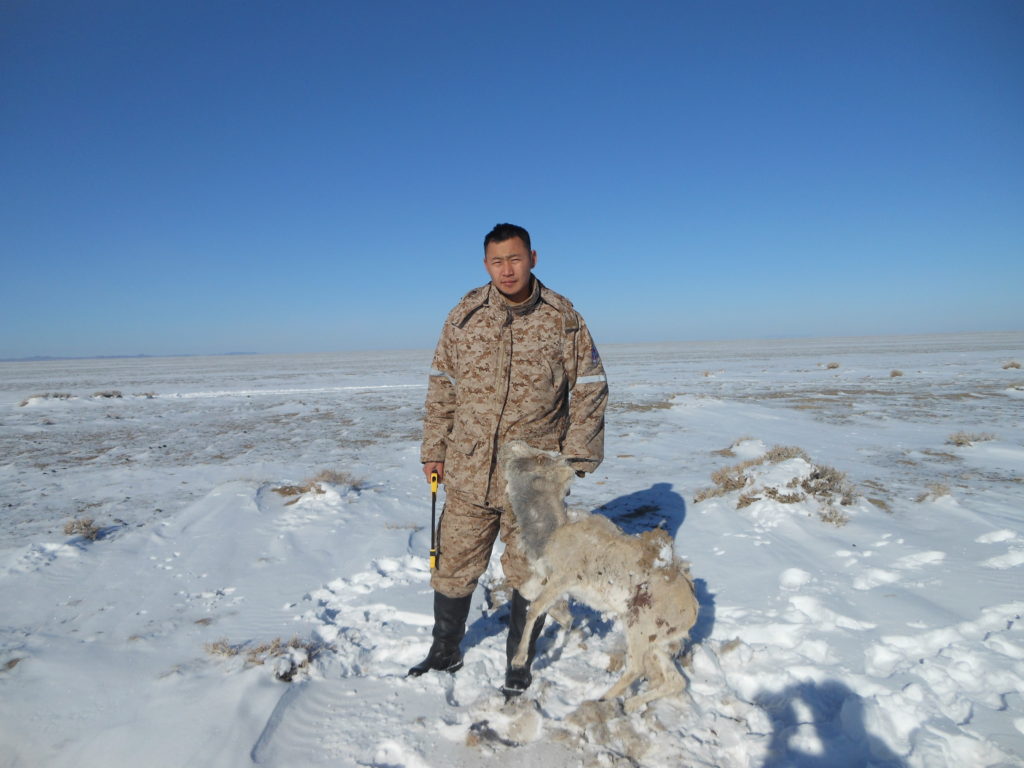Words by Dr Richard Kock, Professor Wildlife Health and Emerging Diseases, Royal Veterinary College, London (Retired).
To celebrate World Veterinary Day 2023 we have a special guest blog from Richard Kock, Former Professor of Wildlife Health and Emerging Diseases at Royal Veterinary College. University of London (2011-2022). He worked as a Veterinary Ecologist and practitioner scientist since 1980. 28 years at the Institute of Zoology, Zoological Society, London mostly resident in Africa and Asia. Awarded FAO international medal (2010) and African Union (IBAR) award (2022) in recognition of his work on global eradication of rinderpest, a pathogen important to food security.

Credit: Duuren Munkhuduuren
Saiga Mass Mortality – what next?
With more and more reports of wildlife disease and mortality, there is growing interest in the phenomena of mass mortality events (MME) specifically, that can affect a wide range of abundant species from mammals to fish. It is important to clarify what we mean though with these human and animal pandemics, as narratives written, are poorly informed by science and often just scaremongering. Common use of terms in English, like mass mortality, can have different meanings according to context. In biological terms, a mass mortality event is very specific, it is a dramatic die-off, involves whole populations and all ages and sexes over a short time frame. MME is relatively rare but historically occurred since life began. Whether such events are on the increase in the Anthropocene, is debatable, but time will tell.
To explain the difference from MME and disease and mortality in general it is best explained as follows: high morbidity and or mortality can occur with any population exposed to novel pathogens whilst MME is fairly unique occurrence and mostly not a new pathogen. An emerging disease is exemplified by COVID 19 in humans but this is not MME. Dramatic maybe but happily with a relatively low case fatality rate (CFR) even if millions of people have died from the virus. The infection of Mongolian saiga with peste des petits ruminants virus in 2017 was another example of a naïve epidemic with high impact. This one caused by virus spilling from livestock movements into the country from China. In wildlife, PPR showed a very high CFR, for example in saiga, killing over 80% of the population in 2017, however this is not an MME. In this case it is humans creating the opportunity for the epidemic in wildlife through livestock management. Another good example of this sort of disease phenomena is the onslaught of highly pathogenic avian influenzas, particularly the sub-type H5N1, generated from poultry industry since 2006, impacting wild birds globally. The risk of both PPR and HPAI could easily be reduced through human dietary change, which would lead to reduction in these animal industries. This is a good discussion point for World Veterinary Day.
Both naïve infections from introduced pathogens and MME from endemic pathogens can have a similar impact on rare and threatened species and are a significant threat in modern times for all species.
Mass mortality in saiga antelope, that occurred in 2015, in the remote natural pastures of central Asia was a true MME. This story is slowly merging into history, whilst this incredibly resilient species now expands rapidly again, with perhaps over a million animals migrating. Good news indeed but the fact that this was not the first event, following on from earlier losses that were poorly documented in the latter part of the 20th Century is a warning, especially as it was not apparently occurring earlier. Here the evidence of an association with unusual environmental climatic conditions, which have literally hotted-up since the mid part of the last century, remains a serious concern for saiga. I would bet a dollar or two that a similar event occurs again but perhaps not for a decade. We need to prepare for this eventuality and continue to apply wide conservation measures to increase the saiga population resilience. The most valuable way to do this is not to have “all eggs in one basket”. This is probably how this species escaped the Pleistocene extinctions along with its ability to run very swiftly and get away from predators and people. Currently the peripheral populations away from the core Central Kazakhstan saiga are relatively vulnerable to extinction (along with the Mongolian subspecies), other than perhaps the Ural population, which has shown a very high relative increase over the last decade and was not affected by the MME in 2015.

Credit: Richard Kock

Credit: Richard Kock
Preventing MME is not I am afraid an option even if reversing some of the triggers might be, such as mitigating against climate change. A large in contact healthy population will be vulnerable to MME wherever it is. Given this situation it is not “biologically” of any particular value for populations to grow exponentially, without natural controls such as predators in place. Without ecosystemic balance between species, the risk of MME will increase and anyway food will ultimately become limiting. Decisions on how and where to manage saiga antelope will need to take these facts into account. Even if a large population is cropped, for whatever use, whilst under threat of MME the absolute size will not matter. This complicates the view of sustainable use. With saiga, it may not be the “use” that is now the main threat since poaching and uncontrolled slaughter has been brought under some level of control. In an MME they will all die however many there are.
Keeping all concerned and the general public, who really empathise with this animal, aware of the concerns and issues, is critical to keeping the species on the radar. Government and NGO focus must remain with the support of international scientists to monitor population and react to MME including biologists, veterinarians and conservation managers.
